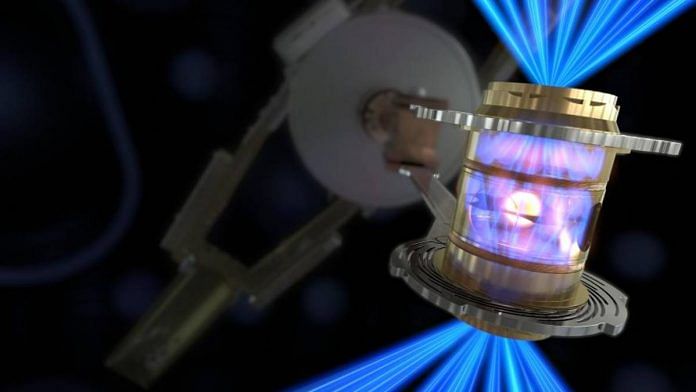Bengaluru: One of the most sought-after quests in the realms of physics is achieving fusion power, or replicating what the Sun does, on Earth. And for the first time, scientists in the United States of America have achieved this, albeit just marginally, by producing a nuclear fusion reaction that released more energy than what was used to power the reaction.
It’s a small net energy gain, but a big step in fusion research, from the Lawrence Livermore National Laboratory military facility. This unlimited source of energy is carbon-free and clean, and if harnessed in the future, could lead to an energy revolution on Earth.
“It is the first time it has ever been done in a laboratory anywhere in the world. Simply put, it is one of the most impressive scientific feats of the 21st century,” said Jennifer M. Granholm., the US Secretary of Energy, in an official announcement Tuesday.
The output produced by the experiment lasted less than a second, but if fusion energy becomes a viable commercial source of power on Earth, one reactor would provide enough energy to power entire cities or even states.
Stars produce energy by combining two atoms to form a single, larger atom, releasing tremendous amounts of energy in the process. Scientists have been wanting to do the same thing on Earth, because fusion energy is an idealistic source of renewable energy and will transform the energy economy — and the world — if realised.
The biggest limitation so far has been that fusion power requires initial energy to power atoms to come together and overcome their innate and strong ability to repel each other at close quarters, and then push them further together to become a completely new element.
There are several government-funded, dedicated, international, collaborative fusion research centres. There are fusion experiments either currently running or being built in 26 countries.
Also read: Who was ‘Sun Queen’ Maria Telkes? Scientists who believed solar energy could replace fossil fuels
Producing 3.15 megajoules of energy output
The National Ignition Facility at Lawrence Livermore, a weapons testing lab, managed to heat a capsule of duterium-tritium (fuel) to over 3 million°C for about a millionth of a second on 5 December. This was done by delivering 2.05 megajoules of energy to the atoms via 192 lasers. The reaction produced 3.15 megajoules of energy output.
However, the energy to power the entire operation was a substantially higher 300 megajoules “from the wall” to charge the lasers.
Officials at the announcement said that the world is “decades” from drawing electricity or commercialising fusion energy.
“There are significant hurdles, not just in science but also technology,” said Kim Budil, director of the Lawrence Livermore, about the commercialisation of this fusion reaction, at the announcement. “With concerted efforts and investment, a few decades could put us in a position to build a commercial power plant,” she added.
Why fusion is so elusive
On Earth today, nuclear power plants use fission reactions, which are the exact opposite of fusion — in fission, an atom is split and releases other atoms, which are radioactive byproducts. It requires far less energy than fusion does.
Fusion reactions require the conditions that are present in stars.
On Earth, this translates to maintaining temperatures of over 150 million degrees Celsius, which is ten times hotter than the centre of the Sun, sustained for a long enough time to facilitate and continue the reaction, at extremely high pressures or compression.
At these conditions, gases do not remain gases, but become a different state of matter called plasma, which is superheated ionic gas.
In some fusion reactors, this plasma is contained using extremely powerful magnets, so that it does not touch the walls of a reactor or a chamber and melt it. Such facilities are called magnetic confinement facilities, and the most common design is a donut-shaped tokamak.
Among developments this year with magnetic confinement, a reactor in South Korea reached temperatures of over 100 million°C for 30 seconds, as did one in UK. In China, a reactor reached temperatures of 70 million°C or five times hotter than the sun, and sustained it for 17 minutes.
The NIF experiment at Lawrence Livermore, on the other hand, used a different type of reactor that worked on the basis of inertial containment, where the target (a pellet typically containing deuterium and tritium atoms) is bombarded with extremely high energy beams, such as lasers. This high energy pushes atoms together creating fusion.
However, the reaction can sustain only as long as the laser beams fire. This requires lasers to deliver constant energy and additional power to keep the lasers running.
The future of fusion
Among the ongoing fusion energy projects across the world, the largest is the ITER, an international fusion research mega project in southern France, with over 12 collaborating countries including India, that is still under construction.
In Gandhinagar’s Institute for Plasma Research, two experimental devices — the ADITYA tokamak and the Steady State Superconducting Tokamak — are working on controlling plasma.
In magnetic confinement facilities such as ITER, getting plasma to sustain high heat and pressures for a few seconds in itself is a major achievement. In inertial confinement facilities, even achieving breakeven, or producing equal fusion output energy as input laser beam energy, has been impossible — until now.
Realising fusion energy has been attempted since the 1950s, and despite this week’s progress, humanity is still quite far away from generating electricity from fusion.
Ideally, fusion energy would require small amounts of fuel, produce extremely large amounts of energy, produce minimal nuclear waste, and be able to shut down quickly.
However, for now, a better alternative to harness energy from is still the fusion reactor in our skies that powers all life on earth.
(Edited by Poulomi Banerjee)
Also read: How Modi govt’s new energy bill aims to bring carbon trading to India, promote non-fossil fuels






